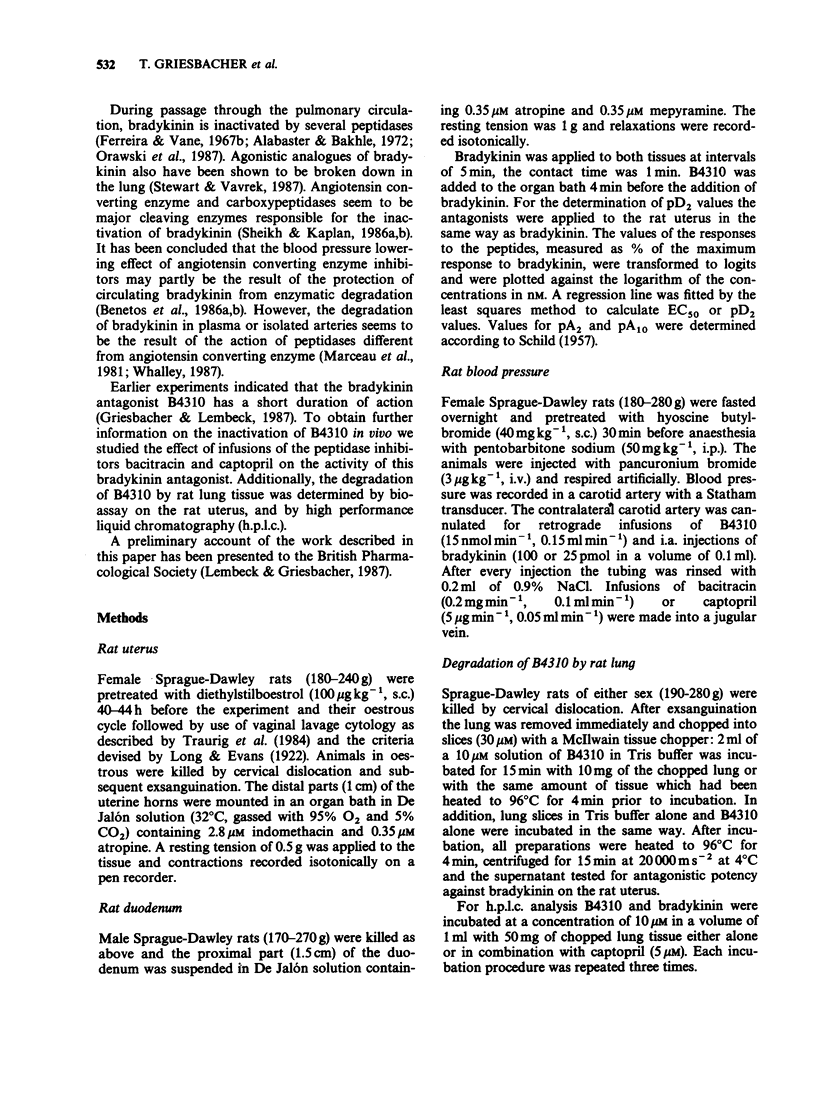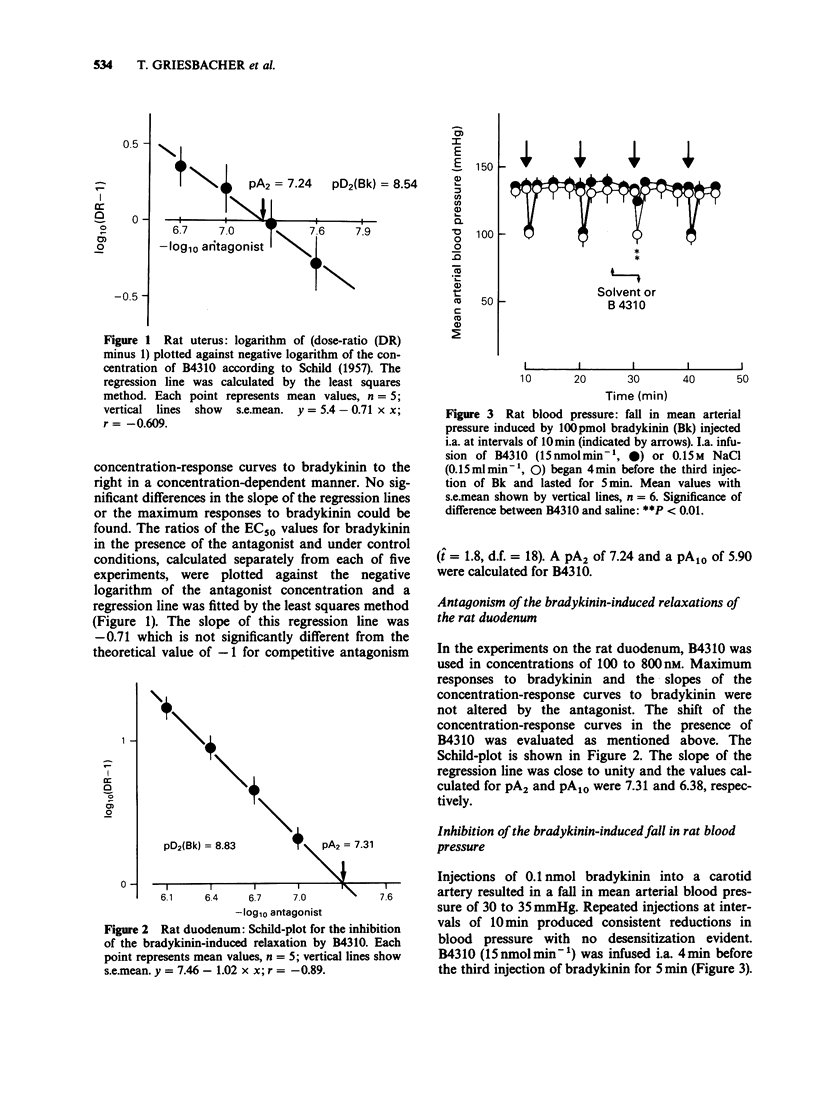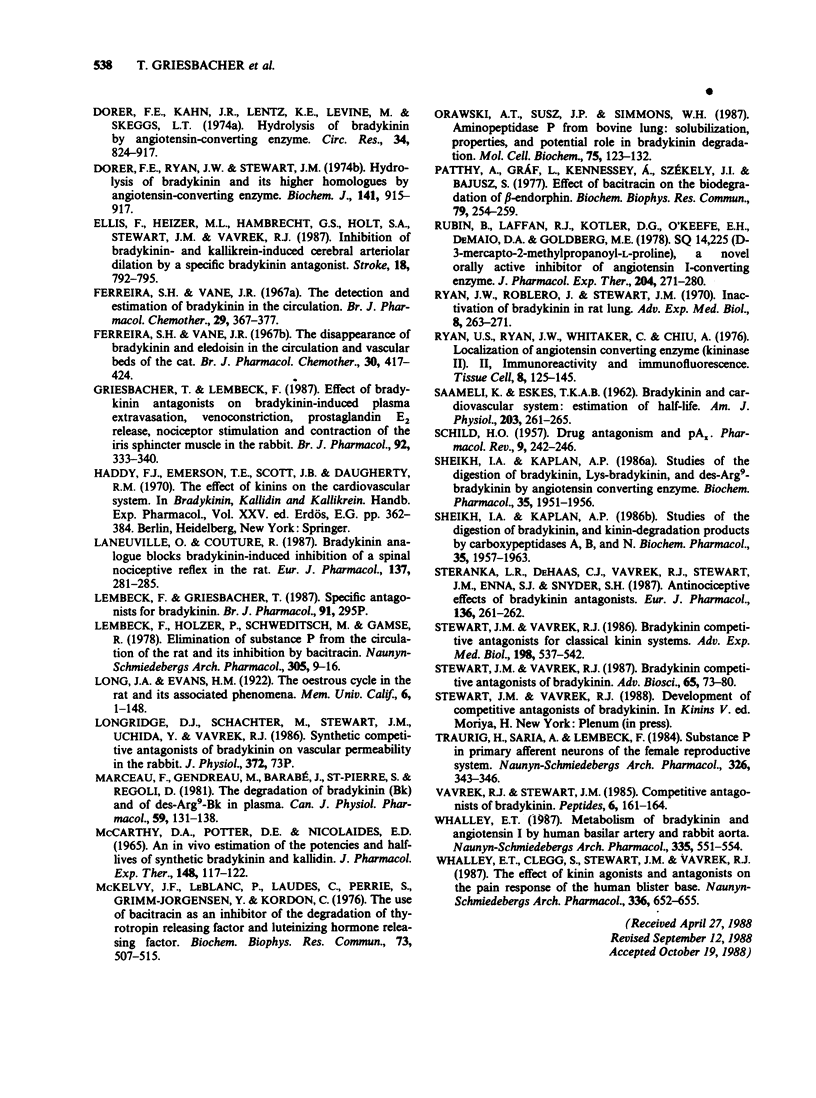Abstract
1. Six competitive bradykinin (Bk) antagonists were tested for their agonistic properties on the rat uterus. Five of these peptides showed agonistic effects only at concentrations at least two orders of magnitude higher than those of bradykinin. 2. The antagonistic potency of Lys-Lys-3-Hyp-5,8-Thi-7-DPhe-Bk (B4310) in the rat uterus (pA2 = 7.24) and in the rat duodenum (pA2 = 7.31) was very similar to that determined in an earlier study for the antagonism of the bradykinin-induced stimulation of the trigeminal nerve in the rabbit iris sphincter muscle preparation (pA2 = 7.59). 3. The fall in mean arterial blood pressure induced by i.a. injections of bradykinin was greatly reduced during an i.a. infusion of B4310, but not 10 min thereafter, which indicates a rapid inactivation of B4310 in vivo. Bacitracin possibly interferes with the enzymatic cleavage of B4310 but seems to have no effect on the degradation of bradykinin. 4. An i.a. infusion of captopril greatly enhanced the potency of bradykinin in inducing a fall in arterial blood pressure, confirming the important role of angiotensin converting enzyme in the cleavage of bradykinin. However, the design of this experiment did not allow conclusions about the effect of captopril on the degradation of B4310. 5. B4310 incubated with rat lung tissue disappeared from the incubation medium within a few minutes, i.e. as fast as bradykinin, which explains its short duration of action in vivo. Captopril partially inhibited the cleavage of both bradykinin and B4310.(ABSTRACT TRUNCATED AT 250 WORDS)
Full text
PDF







Selected References
These references are in PubMed. This may not be the complete list of references from this article.
- Alabaster V. A., Bakhle Y. S. The inactivation of bradykinin in the pulmonary circulation of isolated lungs. Br J Pharmacol. 1972 Jun;45(2):299–310. doi: 10.1111/j.1476-5381.1972.tb08084.x. [DOI] [PMC free article] [PubMed] [Google Scholar]
- Benetos A., Gavras H., Stewart J. M., Vavrek R. J., Hatinoglou S., Gavras I. Vasodepressor role of endogenous bradykinin assessed by a bradykinin antagonist. Hypertension. 1986 Nov;8(11):971–974. doi: 10.1161/01.hyp.8.11.971. [DOI] [PubMed] [Google Scholar]
- Benetos A., Gavras I., Gavras H. Hypertensive effect of a bradykinin antagonist in normotensive rats. Hypertension. 1986 Nov;8(11):1089–1092. doi: 10.1161/01.hyp.8.11.1089. [DOI] [PubMed] [Google Scholar]
- Caldwell P. R., Seegal B. C., Hsu K. C., Das M., Soffer R. L. Angiotensin-converting enzyme: vascular endothelial localization. Science. 1976 Mar 12;191(4231):1050–1051. doi: 10.1126/science.175444. [DOI] [PubMed] [Google Scholar]
- Dorer F. E., Kahn J. R., Lentz K. E., Levine M., Skeggs L. T. Hydrolysis of bradykinin by angiotensin-converting enzyme. Circ Res. 1974 Jun;34(6):824–827. doi: 10.1161/01.res.34.6.824. [DOI] [PubMed] [Google Scholar]
- Dorer F., Ryan J. W., Stewart J. M. Hydrolysis of bradykinin and its higher homologues by angiotensin-converting enzyme. Biochem J. 1974 Sep;141(3):915–917. doi: 10.1042/bj1410915. [DOI] [PMC free article] [PubMed] [Google Scholar]
- Ellis E. F., Heizer M. L., Hambrecht G. S., Holt S. A., Stewart J. M., Vavrek R. J. Inhibition of bradykinin- and kallikrein-induced cerebral arteriolar dilation by a specific bradykinin antagonist. Stroke. 1987 Jul-Aug;18(4):792–795. doi: 10.1161/01.str.18.4.792. [DOI] [PubMed] [Google Scholar]
- Ferreira S. H., Vane J. R. The detection and estimation of bradykinin in the circulating blood. Br J Pharmacol Chemother. 1967 Mar;29(3):367–377. doi: 10.1111/j.1476-5381.1967.tb01968.x. [DOI] [PMC free article] [PubMed] [Google Scholar]
- Ferreira S. H., Vane J. R. The disappearance of bradykinin and eledoisin in the circulation and vascular beds of the cat. Br J Pharmacol Chemother. 1967 Jun;30(2):417–424. doi: 10.1111/j.1476-5381.1967.tb02148.x. [DOI] [PMC free article] [PubMed] [Google Scholar]
- Griesbacher T., Lembeck F. Effect of bradykinin antagonists on bradykinin-induced plasma extravasation, venoconstriction, prostaglandin E2 release, nociceptor stimulation and contraction of the iris sphincter muscle in the rabbit. Br J Pharmacol. 1987 Oct;92(2):333–340. doi: 10.1111/j.1476-5381.1987.tb11328.x. [DOI] [PMC free article] [PubMed] [Google Scholar]
- Laneuville O., Couture R. Bradykinin analogue blocks bradykinin-induced inhibition of a spinal nociceptive reflex in the rat. Eur J Pharmacol. 1987 Jun 4;137(2-3):281–285. doi: 10.1016/0014-2999(87)90237-8. [DOI] [PubMed] [Google Scholar]
- Lembeck F., Holzer P., Schweditsch M., Gamse R. Elimination of substance P from the circulation of the rat and its inhibition by bacitracin. Naunyn Schmiedebergs Arch Pharmacol. 1978 Oct;305(1):9–16. doi: 10.1007/BF00497000. [DOI] [PubMed] [Google Scholar]
- MCCARTHY D. A., POTTER D. E., NICOLAIDES E. D. AN IN VIVO ESTIMATION OF THE POTENCIES AND HALF-LIVES OF SYNTHETIC BRADYKININ AND KALLIDIN. J Pharmacol Exp Ther. 1965 Apr;148:117–122. [PubMed] [Google Scholar]
- Marceau F., Gendreau M., Barabé J., St-Pierre S., Regoli D. The degradation of bradykinin (BK) and of des-Arg9-BK in plasma. Can J Physiol Pharmacol. 1981 Feb;59(2):131–138. doi: 10.1139/y81-022. [DOI] [PubMed] [Google Scholar]
- McKelvy J. F., LeBlanc P., Laudes C., Perrie S., Grimm-Jorgensen Y., Kordon C. The use of bacitracin as an inhibitor of the degradation of thyrotropin releasing factor and luteinizing hormone releasing factor. Biochem Biophys Res Commun. 1976 Nov 22;73(2):507–515. doi: 10.1016/0006-291x(76)90736-1. [DOI] [PubMed] [Google Scholar]
- Orawski A. T., Susz J. P., Simmons W. H. Aminopeptidase P from bovine lung: solubilization, properties, and potential role in bradykinin degradation. Mol Cell Biochem. 1987 Jun;75(2):123–132. doi: 10.1007/BF00229900. [DOI] [PubMed] [Google Scholar]
- Patthy A., Gráf L., Kenessey A., Székely J. I., Bajusz S. Effect of bacitracin on the biodegradation of beta-endorphin. Biochem Biophys Res Commun. 1977 Nov 7;79(1):254–259. doi: 10.1016/0006-291x(77)90088-2. [DOI] [PubMed] [Google Scholar]
- Rubin B., Laffan R. J., Kotler D. G., O'Keefe E. H., Demaio D. A., Goldberg M. E. SQ 14,225 (D-3-mercapto-2-methylpropanoyl-l-proline), a novel orally active inhibitor of angiotensin I-converting enzyme. J Pharmacol Exp Ther. 1978 Feb;204(2):271–280. [PubMed] [Google Scholar]
- Ryan U. S., Ryan J. W., Whitaker C., Chiu A. Localization of angiotensin converting enzyme (kininase II). II. Immunocytochemistry and immunofluorescence. Tissue Cell. 1976;8(1):125–145. doi: 10.1016/0040-8166(76)90025-2. [DOI] [PubMed] [Google Scholar]
- SAAMELI K., ESKES T. K. Bradykinin and cardiovascular system: estimation of half-life. Am J Physiol. 1962 Aug;203:261–265. doi: 10.1152/ajplegacy.1962.203.2.261. [DOI] [PubMed] [Google Scholar]
- SCHILD H. O. Drug antagonism and pAx. Pharmacol Rev. 1957 Jun;9(2):242–246. [PubMed] [Google Scholar]
- Sheikh I. A., Kaplan A. P. Studies of the digestion of bradykinin, Lys-bradykinin, and des-Arg9-bradykinin by angiotensin converting enzyme. Biochem Pharmacol. 1986 Jun 15;35(12):1951–1956. doi: 10.1016/0006-2952(86)90726-4. [DOI] [PubMed] [Google Scholar]
- Sheikh I. A., Kaplan A. P. Studies of the digestion of bradykinin, lysyl bradykinin, and kinin-degradation products by carboxypeptidases A, B, and N. Biochem Pharmacol. 1986 Jun 15;35(12):1957–1963. doi: 10.1016/0006-2952(86)90727-6. [DOI] [PubMed] [Google Scholar]
- Steranka L. R., DeHaas C. J., Vavrek R. J., Stewart J. M., Enna S. J., Snyder S. H. Antinociceptive effects of bradykinin antagonists. Eur J Pharmacol. 1987 Apr 14;136(2):261–262. doi: 10.1016/0014-2999(87)90723-0. [DOI] [PubMed] [Google Scholar]
- Stewart J. M., Vavrek R. J. Bradykinin competitive antagonists for classical kinin systems. Adv Exp Med Biol. 1986;198(Pt A):537–542. doi: 10.1007/978-1-4684-5143-6_71. [DOI] [PubMed] [Google Scholar]
- Traurig H., Saria A., Lembeck F. Substance P in primary afferent neurons of the female rat reproductive system. Naunyn Schmiedebergs Arch Pharmacol. 1984 Jul;326(4):343–346. doi: 10.1007/BF00501440. [DOI] [PubMed] [Google Scholar]
- Vavrek R. J., Stewart J. M. Competitive antagonists of bradykinin. Peptides. 1985 Mar-Apr;6(2):161–164. doi: 10.1016/0196-9781(85)90033-6. [DOI] [PubMed] [Google Scholar]
- Whalley E. T., Clegg S., Stewart J. M., Vavrek R. J. The effect of kinin agonists and antagonists on the pain response of the human blister base. Naunyn Schmiedebergs Arch Pharmacol. 1987 Dec;336(6):652–655. doi: 10.1007/BF00165756. [DOI] [PubMed] [Google Scholar]
- Whalley E. T. Metabolism of bradykinin and angiotensin I by human basilar artery and rabbit aorta. Naunyn Schmiedebergs Arch Pharmacol. 1987 May;335(5):551–554. doi: 10.1007/BF00169123. [DOI] [PubMed] [Google Scholar]


